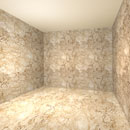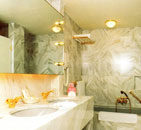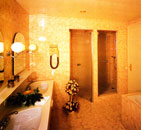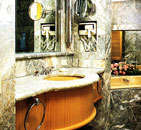
Quarry
Quarry is the practice of finishing all planar surfaces in one material, pattern and color, with the exception of one plane that receives a different material. The similarly treated planes emphasize a smooth seamlessness of a single material; the differing plane is deemphasized. more
Quarry | Hotel
application
In hotel design, Quarry is a material strategy for imparting luxury in and adding visual interest to bathrooms; floors and walls are finished with an expensive material, such as stone, while the ceiling is deemphasized.
research
Quarry breaks from the typical practice of finishing a room with three planar treatments: one for walls, another for the floor, and another for the ceiling. Any plane is available for singling out for the differing treatment, but in hotel design, floors and walls often receive the same material, while the ceiling is the independent plane. The independent plane is neutral; it deemphasizes, recedes, or fades. The independent plane is never treated as an accent plane, because it is the materiality of the other planes that is emphasized. The plane unlike the others ensures that the effect of the similarly treated planes does not create an overwhelming or oppressive environment for the user (as might be the case if all walls were treated in the same material, like in the Camouflage Intype).1
In hotel design, Quarry is a material strategy for imparting luxury through the use of an expensive material applied to additional surfaces than would be traditionally appropriate; opulence in this case is derived from excess. This prevalent Intype is seen in hotel bathrooms that have their floor and all vertical surfaces finished with the same stone, usually marble. This approach is so pervasive that it has become a standard practice to elevate the status of even a modest bathroom in the industry.
Quarry is also strategically used to give character and visual excitement to spaces that may lack architectural interest.2 The Intype inherently creates unexpected interiors due to cladding at least one plane in a material that is traditionally foreign to it: for example, walls may be completely covered in stone usually reserved for flooring. The planes with the shared finish are meant to visually blend together, and to not be viewed as independent entities. The points where the planes merge support this intent and are neutrally treated; where a similarly clad wall and floor join, there is no base treatment. Quarry is particularly effective because it has the ability to drastically alter how a room is perceived through only a surface treatment. In a Quarried room the connections of the planes disappear, and the effect is holistic, what you see and feel is contiguous material--grain and color dominate.3
Chronological Sequence
Quarry entered the vernacular of hotel bathroom design in the late 1970 decade. These bathrooms typically had all walls and floor covered in the same finish, usually stone such as marble, while the ceiling was simple painted gypsum. Built in 1906, The Palace Luzern in Switzerland was initially famous for having an unusually high number of bathrooms.4 The hotel had a difficult history riddled with neglect, but by the 1970 decade, it was brought back to its former glory through a decade-long renovation. During this process the hotel once again focused on bathrooms, this time creating well-appointed baths in all of their 165 guestrooms. The spacious bathrooms at the Palace Luzern were deemed perfect for "pampering the guest in marble luxury"5 as the similarly clad walls and floor seamlessly flowed from one plane into another.6 This treatment was clearly intentional as there was no change in tile pattern where the walls connected to the floor.
This practice of Quarried marble bathrooms continued into the 1980 decade, which was a period of immense growth in the hotel industry not seen since the 1950 decade with the advent of commercial air travel.7 Historic hotels such as the Hotel De L'Europe, a luxury hotel in Amsterdam, were being renovated to compete with newer establishments. When showcasing the Hotel De L'Europe's renovation, International Hotel and Resort Design stated, "Modern bathrooms are musts especially for historic 5-star hotels. Gleaming marble surfaces and gold toned fixtures lend to unmistakable luxury."8 The hotel certainly helped maintain its ranking by featuring Quarried marble bathrooms9 in its eighty guestrooms and twenty suites.
The Quarry bathroom aesthetic was not limited to Europe, and the bathrooms of the Regent Okinawa10 featured the practice as well. Media Five Limited was responsible for entire design of the hotel, and the firm strove to create dramatic, contemporary interiors that were timeless through the use of high-quality, classic materials.11 The grey marble in the bathroom kept with the hotel's overall scheme (marble was also used in the lobby for the reception desk and staircase), while the sheer quantity of the stone in the bathroom identified the space as its own independent retreat within the guestroom.
Designed with the concept of being a "jewel case," the Clarion Hotel opened in 1992 as a small urban resort hotel in Kuraskiki, Japan.12 Although the bathroom's walls and floor were clad in the same brown stone, there were subtle differences in the size and orientation of the tiles.13 The rectangular stones of the walls were oriented lengthwise, but square tiles oriented at a 45-degree angle to the door comprised the floor. The room's simple white ceiling almost disappeared in this composition. It is interesting to note that because the bathroom is clad in a dark stone it is most likely perceived as smaller than if it were, for example, painted white. Here the designers of Mitsukoshi, Ltd. felt that the guests would respond more favorably to the luxury suggested by the stone than to the implications of a more spacious bath.
Quarry was a globally used archetype, and it was featured in the landmark renovation of New York City's Four Seasons Hotel in 1993. Chhada Siembieda Associates featured it in their designs for the guest quarters including the three thousand square foot presidential suite on the fifty-second floor. By employing Quarry in the world-renowned hotel's most expensive suite,14 it is clear that the practice was understood as the unequivocal symbol of bathroom luxury and refinement.
Although almost all Quarry bathrooms feature marble, it is not a requirement of the Intype. Kelly Wearstler, head of Kwid design, cleverly used glass mosaic tiles to create the desired holistic effect in the Hard Rock Hotel's expansive
high-roller suite.15 All of the walls, floor, and even the Island (Intype)16 bathtub are covered in the material. Marble tends to be used not only for its beauty, but because of how seamlessly it can clad a surface. Average ceramic tiles, conversely, would feature aesthetically disruptive grout lines if they were used to cover a whole bathroom. Because the designer used tiles of such a small scale, though, she was able to create an uninterrupted effect that enables the surfaces read as one.
When Yabu Pushelberg designed the seventy-seven-suite Hazelton Hotel (2008) in Toronto, the firm sought to create a romantic glamour and evoke longevity through their strategic use of materials. Marble was one of the quality finishes used generously throughout the hotel, and was incorporated in the lobby, the spa, and in the suites' bathrooms. The hotel's premiere suite, at 1,800 square feet, featured a bath larger than most chain hotel guestrooms and had full-length mirrors, a spacious soaking tub, a plasma television, and generous changing area. Further articulating its opulence, the bathroom was clad from floor to ceiling in dark, beautifully veined marble.17
At the beginning of the 2010 decade, the President Hotel in New York City -Best Western's flagship hotel- opened after being completely renovated by Stonehill & Taylor Architects. The 334-room, fifteen-floor hotel adopted Quarry in its suites' bathrooms.18 This decision can be viewed as a strategy for securing the suites' luxury status; Best Western is, after all, a corporation of mid-level chain hotels. By adhering to the luxury hotel benchmark of bathrooms clad in marble, the designers sought to have their suites viewed as equitable to those of established luxury brands.
Conclusion
Quarry continues to grow in prevalence in the hotel practice type. Since appearing in the 1970 decade, Quarry became an internationally recognized benchmark of luxury. This treatment of the bathroom has its roots in high-end hotels, but as with any popular trend, the aesthetic has trickled down; Quarry can now be seen in lower price point hotels, including chain establishments. These hotels may not be able to afford the quality stone used in the luxury enterprises, but they still clad all walls and floor in one material, whether it is with imitation stone or subway tile. These iterations miss the mark in terms of the original strategy behind the practice (enveloping the user in high-quality, expensive materials), yet they still remain effective in producing an aesthetic that is desirable to its user because it recognizably emulates an accepted higher-end standard. Regardless of the class of hotel and the cost of materials, there is no evidence that Quarry will be discontinued in hotel design.19
end notes
- 1) Intypes researcher Elizabeth O'Brein identified Camouflage in her 2006 material study. Camouflage refers to the application of a consistent pattern to the wall, floor, and ceiling planes, as well as furnishings. Wrapping the interior with a continuous pattern effectively blurs the transition between horizontal and vertical planes or between planes and furnishings. Elizabeth O'Brien. "Material Archetypes: Contemporary Interior Design and Theory Study." M.A. Thesis, Cornell University, 2006, 132-139.
- 2) Anonymous, "Print Play," Interior Design 42, no.11 (Nov. 1971): 96-97.
- 3) Jan Jennings, e-mail message to author, August 16, 2010.
- 4) Anne M. Schmid and Mary Scoviak-Lerner, International Hotel and Resort Design (New York City: PBC International, 1988), 175.
- 5) Schmid, International Hotel and Resort Design, 175.
- 6) Bathroom, Palace Luzern [1971] Anonymous, Interior Design; Anonymous, Architecture; Lucerne, Switzerland in Anne M. Schmid and Mary Scoviak-Lerner, International Hotel and Resort Design (New York City: PBC International, 1988), 175; PhotoCrd: Anonymous.
- 7) Walter A. Rutes, et al, Hotel Design: Planning and Development (London, England: W. W. Norton & Company, Ltd., 2001): 11.
- 8) Schmid, International Hotel and Resort Design, 17.
- 9) Bathroom, Hotel De L'Europe [c1985] Maurice Grothausen, Interior Design; Maurice Grothausen, Architecture; Amsterdam, Netherlands in Anne M. Schmid and Mary Scoviak-Lerner, International Hotel and Resort Design (New York City: PBC International, 1988), 16; PhotoCrd: Anonymous.
- 10) Bathroom, Regent Okinawa [c1985] Media Five Limited, Interior Design; Media Five Limited, Architecture; Okinawa, Japan in Anne M. Schmid and Mary Scoviak-Lerner, International Hotel and Resort Design (New York City: PBC International, 1988), 34; PhotoCrd: Anonymous.
- 11) Schmid, International Hotel and Resort Design, 34.
- 12) Meisei Shuppan, New Hotel Architecture: Modern Hotel Design: A Pictorial Survey (Tokyo, Japan: Meisei Publications, 1993), 75.
- 13) Bathroom, Clarion Hotel [1992] F&N Architect Associates, Mitsukoshi, Ltd., Interior Design; F&N Architect Associates, Architecture; Kuraskiki, Japan in Meisei Shuppan, New Hotel Architecture: Modern Hotel Design: A Pictorial Survey (Tokyo, Japan: Meisei Publications, 1993), 75; PhotoCrd: Mitsuo Matsuoka.
- 14) Bathroom, Four Seasons Hotel [1993] Chhada Siembieda Associates, Interior Design; Pei Cobb Freed & Partners, Frank Williams & Associates, Architecture; New York City in Monica Geran, in "Chhada Siembieda," Interior Design 64, no.10 (Oct. 2000): 237; PhotoCrd: Anonymous.
- 15) Bathroom, Hard Rock Hotel [2005] Kwid, Interior Design; Anonymous, Architecture; Las Vegas, NV in Edie Cohen, "Rock and Roll," Interior Design 76, no.3 (Mar. 2005): 193; PhotoCrd: John Coolidge.
- 16) Intypes researcher Rachel Goldfarb identified Island in her 2008 resort and spa study. Island refers to an isolated interior object that is detached from the walls and positioned to be approached from all of its sides; it becomes a center of attention. Goldfarb, Rachel. "Theory Studies: Archetypical Practices of Contemporary Resort and Spa Design." M.A. Thesis, Cornell University, 2008, 98-103.
- 17) Bathroom, Hazelton Hotel [2008] Yabu Pushelberg, Interior Design; Paige+Steele Incorporated Architects, Architecture; Toronto, Canada in Mark Pupo, in "In the Lap of Luxury," Interior Design 79, no.2 (Feb. 2008): 219; PhotoCrd: Evan Dion
- 18) Bathroom, The President [2010] Stonehill & Taylor Architects, Interior Design; Stonehill & Taylor Architects, Architecture; New York City; PhotoCrd: Nathan Wasliewski, Intypes Project (May 2010).
- 19) Evidence for the archetypical use and the chronological sequence of Harlequin in hotels was developed from the following sources: 1970 Bathroom, Palace Luzern [1971] Anonymous, Interior Design; Anonymous, Architecture; Lucerne, Switzerland in Anne M. Schmid and Mary Scoviak-Lerner, International Hotel and Resort Design (New York City: PBC International, 1988), 175; PhotoCrd: Anonymous / 1980 Bathroom, Hotel De L'Europe [c1985] Maurice Grothausen, Interior Design; Maurice Grothausen, Architecture; Amsterdam, Netherlands in Schmid, International Hotel and Resort Design, 16; PhotoCrd: Anonymous.; Bathroom, Regent Okinawa [c1985] Media Five Limited, Interior Design; Media Five Limited, Architecture; Okinawa, Japan in Schmid, International Hotel and Resort Design, 34; PhotoCrd: Anonymous / 1990 Bathroom, Clarion Hotel [1992] F&N Architect Associates, Mitsukoshi, Ltd., Interior Design; F&N Architect Associates, Architecture; Kuraskiki, Japan in Meisei Shuppan, New Hotel Architecture: Modern Hotel Design, A Pictorial Survey (Tokyo, Japan: Meisei Publications, 1993), 75; PhotoCrd: Mitsuo Matsuoka; Bathroom, Four Seasons Hotel [1993] Chhada Siembieda Associates, Interior Design; Pei Cobb Freed & Partners, Frank Williams & Associates, Architecture; New York City in Monica Geran, in "Chhada Siembieda," Interior Design 64, no.10 (Oct. 2000): 237; PhotoCrd: Anonymous / 2000 Bathroom, Hard Rock Hotel [2005] Kwid, Interior Design; Anonymous, Architecture; Las Vegas, NV in Edie Cohen, in "Rock and Roll," Interior Design 76, no.3 (Mar. 2005): 193; PhotoCrd: John Coolidge; Bathroom, Hazelton Hotel [2008] Yabu Pushelberg, Interior Design; Paige+Steele Incorporated Architects, Architecture; Toronto, Canada in Mark Pupo, in "In the Lap of Luxury," Interior Design 79, no.2 (Feb. 2008): 219; PhotoCrd: Evan Dion / 2010 Bathroom, The President [2010] Stonehill & Taylor Architects, Interior Design; Stonehill & Taylor Architects, Architecture; New York City; PhotoCrd: Nathan Wasliewski, Intypes Project (May 2010).





